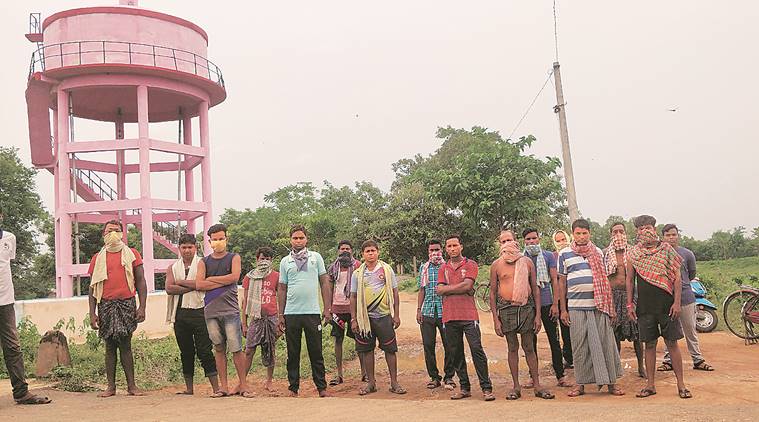- India
- International
In Ground Zero Ganjam, why NREGS isn’t answer
Covid hits NREGS staff, returning migrants not keen on unskilled work
 Workers who returned from Surat, in Ganjam. Express Photo by Aishwarya Mohanty
Workers who returned from Surat, in Ganjam. Express Photo by Aishwarya Mohanty
HE WAS just 16 when he left his village in Odisha’s Ganjam 13 years ago to join his father at a powerloom factory in Gujarat’s Surat. And till about four months ago, he used to earn Rs 20,000-22,000 a month with a free meal every day. But now, Susanta Gouda is back in Nuapalli village, trying his luck at fishing. “Last month, I managed to earn around Rs 9,000 from selling fish,” he says. With over 4 lakh migrant workers returning to Ganjam, making the coastal district the Ground Zero of lockdown distress, Gouda signed up for work under the National Rural Employment Guarantee Scheme (NREGS) soon after coming home two months ago. “But I gave up. The money was too little,” he says.
Read | UNESCO recognises two Odisha villages as Tsunami Ready
He is not alone. In the rest of the country, the NREGS has come as succour to returning workers, but in Ganjam, the scheme itself has taken a hit. Reason: There has been a rapid spread of Covid among NREGS supervisors and field staff who coordinate with job-seekers. And, officials say, many of the returning migrants, mostly from Gujarat, Chennai and Mumbai, are skilled workers who are not keen on unskilled labour and want to earn more.
Over the past two months, at least 50 junior engineers and assistant engineers with the District Rural Development Authority (DRDA) have been infected, with one death.
Read | Naveen Patnaik’s home district Ganjam first in Odisha to record 10,000 COVID-19 cases
“They are our field workers who coordinate with villagers, develop muster rolls and get work done on the ground. With so many infected, it becomes difficult at the implementation level,” says Krushnachandra Panda, Officer on Special Duty for the NREG scheme in Ganjam.

The numbers reflect the situation. Ganjam generated 2,18,342 person days of work under the scheme in April, 22,09,511 in May and 25,11,428 in June. But with the district topping the Covid chart in Odisha — it has logged 11,812 cases so far — the number dipped to 16,29,552 in July.
So much so, that on August 3, the DRDA logged only 21,683 person days from a high of 83,714 on an average per day in June.
“As the migrants returned, a lot of projects were taken up to provide employment. But they weren’t satisfied with the unskilled labour and wages provided,” says Reena Padhi, the district coordinator for the scheme.
Read | Unlock 3: Odisha releases guidelines, night curfew to remain till August 31
The outbreak among work supervisors hasn’t helped, either. “We work in close contact with a large number of people, and are cautious. But there are a lot of asymptomatic cases, which makes it risky. We go out with basic protection, like masks and sometimes gloves,” says an assistant engineer, who did not wish to be identified.
The DRDA project director in Ganjam, Siddharth Shankar Swain, says safety protocols have been defined and protective gear provided. “But the spread of infection among ground-level engineers is inevitable,” he says.
“A lot of them stay in Behrampur, which has the maximum number of cases (2,222) in the district. They have also worked in close proximity with people returning to Ganjam from other states, including hotspots. On an average every day, we were dealing with about 10,000 returning migrants. All our junior engineers were also deployed at temporary health camps set up for those workers,” says Swain.
“We have provided staff with protective kits, including gloves, masks and reusable PPE kits. We have distributed about 50,000 such kits among non-medical staff. We have also asked all our staff members who are above 50 years of age to not to visit the field,” he says.
Back in Nuapalli village, Gouda wants to leave again for Surat “as soon as possible”. About 40 km away, Laxman Behera (26) is part of a group of 15 that wants to return to the textile hub, too. “There are no jobs here, and Rs 207 a day under NREGS feels so meagre. In Surat, the mills are functional again, and they want us back. But this time, we want our employers to ensure that if a similar situation arises again, they won’t leave us to starve,” he says.
Apr 25: Latest News
- 01
- 02
- 03
- 04
- 05








































